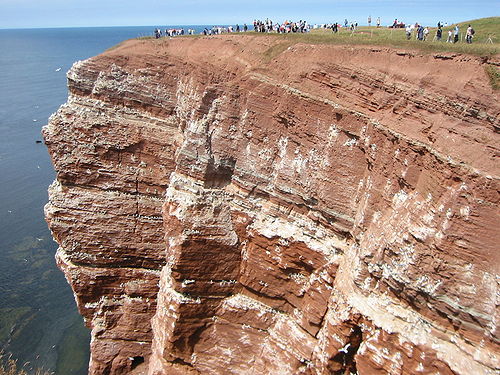Sedimentary Rocks
You probably recognize the Figure 4.10 as the White House, the official home and workplace of the President of the United States of America. Do you know why the White House is white? Its color has a lot to do with the stone materials that were used to construct it.
Construction for the White House began in 1792, and most of the work was carried out by people who had only recently come to the newly formed country of America. Its outside walls are made of a type of sedimentary rock called sandstone. The sandstone that was used to construct the White House is very porous, which means that rainwater can easily penetrate the sandstone. This made the White House susceptible to water damage in its early days of construction. To stop the water damage, workers had to cover the sandstone in a mixture of salt, rice, and glue, giving the White House its distinct white color.
- Describe how sedimentary rocks are formed.
- Describe the properties of some common sedimentary rocks.
- Relate some common uses of sedimentary rocks.
Sediments
In this lesson, you will learn about sedimentary rocks like sandstone, how they form, how they are classified, and how people often use sedimentary rocks.
Sedimentary rocks are formed by the compaction of sediments. Sediments may include:
- fragments of other rocks that have been worn down into small pieces, like sand,
- organic materials, or in other words, the remains of once-living organisms,
- or chemical precipitates, which are materials that get left behind after the water evaporates from a solution.
Most sediments settle out of water (Figure 4.11). For example, running water in rivers carries huge amounts of sediments. The river dumps these sediments along its banks and at the end of its course. When sediments settle out of water, they form horizontal layers. One layer at a time is put down. Each new layer forms on top of the layers that were already there. Thus, each layer in a sedimentary rock is younger than the layer under it and older than the layer over it. When the sediments harden, the layers are preserved. In large outcrops of sedimentary rocks, you can often see layers that show the position and order in which the original sediment layers were deposited. Scientists can figure out the relative ages of layers by knowing that older ones are on the bottom and younger ones are on top.
There are many different types of environments where sedimentary rocks form. Some places where you can see large deposits of sediments today include a beach and a desert. Sediments are also continuously depositing at the bottom of the ocean and in lakes, ponds, rivers, marshes and swamps. Avalanches produce large unsorted piles of sediment. The environment where the sediments are deposited determines the type of sedimentary rock that will form there.
Sedimentary Rock Formation
Sediments accumulate and over time may be hardened into rock. Lithification is the hardening of layers of loose sediment into rock (Figure 4.12). Lithification is made up of two processes: cementation and compaction. Cementation occurs when substances crystallize or fill in the spaces between the loose particles of sediment. These cementing substances come from the water that moves through the sediments. Sediments may also be hardened into rocks through compaction. This occurs when sediments are squeezed together by the weight of layers on top of them. Sedimentary rocks made of cemented, non-organic sediments are called clastic rocks. Those that form from organic remains are called bioclastic rocks, and sedimentary rocks formed by the hardening of chemical precipitates are called chemical sedimentary rocks. Table 4.2 shows some common types of sedimentary rocks and the types of sediments that make them up.
Note from the pictures in the table that clastic sedimentary rocks vary in the size of their sediments. Both conglomerate and breccia are made of individual stones that have been cemented together. In conglomerate, the stones are rounded; in breccia, the stones are angular around the edges. Sandstone is made of smaller, mostly sand-sized particles cemented together. Siltstone is made mostly of silt, particles that are smaller than sand but larger than clay. Shales have the smallest grain size, being made mostly of clay-sized particles and hardened mud.
Lesson Summary
- Weathering and erosion produce sediments. Once these sediments are deposited, they can become sedimentary rocks.
- Sediments must be compacted and cemented to make sedimentary rock. This process is called lithification.
Review Questions
- What are three things that the sediments in sedimentary rocks may be made of?
- If you see a sedimentary rock outcrop and red layers of sand are on top of pale layers of sand, what do you know for sure about the ages of the two layers?
- Why do sedimentary rocks have layers of different colors sometimes?
- Describe the two processes necessary for sediments to harden into rock.
- What type of sedimentary rock is coal?
- Think back to the story at the start of the lesson about why the White House originally was white. Why do you think sandstone would be a particularly porous rock?
Vocabulary
- cementation
- Occurs when substances harden crystallize in the spaces between loose sediments.
- lithification
- The hardening of layers of loose sediment into rock
- organic
- Made from materials that were once living things.
- outcrop
- Large rock formation at the surface of the Earth.
- precipitate
- The solid materials left behind after a liquid evaporates.
- compaction
- Occurs when sediments are hardened by being squeezed together by the weight of layers on top of them.














